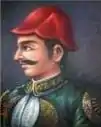Karbir Pande
Kaji Karbir Pande (Nepali: करबिर पाँडे) was one of the sons of Mulkaji Damodar Pande.[1] After King Rana Bahadur's reinstatement to power, he ordered the execution of Damodar Pande, along with his two eldest sons, who were completely innocent, to be executed on 13 March 1804; similarly some members of his faction were tortured and executed without any due trial, while many others managed to escape to India. Karbir Pande was among those who managed to escape to India along with his brother Rana Jang Pande and cousin Ranabam Pande.[1][1][2]
Karbir Pande | |
|---|---|
श्री काजी करबिर पाँडे | |
| Personal details | |
| Died | 18 April 1843 |
| Father | Mulkaji Damodar Pande |
| Relatives | Bamsa Raj Pande (uncle) Damodar Pande (father) Kalu Pande (grand father) Rana Jang Pande (brother) |
| Military service | |
| Allegiance | Kingdom of Nepal |
| Branch/service | Nepal Army |
| Rank | Kaji |
Career

In January 1838, King Rajendra of Nepal promoted Rana Jang Pande to the post of Commander in the armed force and his brother Karbir Pande as Kapardar ("Palace Chief Guard"). As a result, almost one hundred officers and soldiers resigned from the Singha Nath Battalion, openly calling themselves as the private followers of Mathawar Singh which showcased the popularity of Mathawar Singh in the military forces.[3]
Death

Mathabarsingh Thapa arrived in Kathmandu Valley in 1843 April 17 where a great welcome was organized for him.[4] After Mathabarsingh Thapa secured his position in the palace, he successfully led to the murder of Karbir Pande along with all his political adversaries namely Kulraj Pande, Ranadal Pande, Indrabir Thapa, Ranabam Thapa, Kanak Singh Basnet, Gurulal Adhikari and many others, in several pretexts.[5] Karbir Pande's ailing elder brother Rana Jang Pande was forced to see the murdered dead bodies of his brothers and nephews on April 18, 1843. Rana Jang lying ill in his bed was not given death sentence. Rana Jang was shocked to death after seeing the dead bodies of his brothers and nephews on 18 April 1843. [5]
References
- Acharya 2012, p. 54.
- Nepal 2007, p. 57.
- Pradhan 2012, p. 165.
- Sharma, Balchandra (1976). Nepal ko Aitehasik Rooprekha. Varanasi: Krishna Kumari Devi. p. 295.
- Acharya 1971, p. 17.
Bibliography
- Acharya, Baburam (1971), "The Fall of Bhimsen Thapa and The Rise of Jang Bahadur Rana" (PDF), Regmi Research Series, Kathmandu, 3: 214–219
- Acharya, Baburam (2012), Acharya, Shri Krishna (ed.), Janaral Bhimsen Thapa : Yinko Utthan Tatha Pattan (in Nepali), Kathmandu: Education Book House, p. 228, ISBN 9789937241748
- Nepal, Gyanmani (2007), Nepal ko Mahabharat (in Nepali) (3rd ed.), Kathmandu: Sajha, p. 314, ISBN 9789993325857
- Pradhan, Kumar L. (2012), Thapa Politics in Nepal: With Special Reference to Bhim Sen Thapa, 1806–1839, New Delhi: Concept Publishing Company, p. 278, ISBN 9788180698132